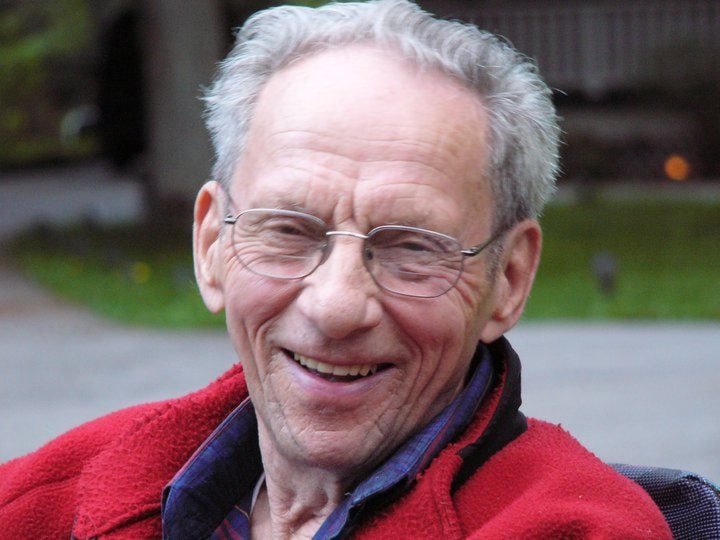The launch of a newly digitized photo collection by Touchstones Nelson Saturday unexpectedly became a memorial for the man responsible for many of the images.
Prolific photographer Art Stevens, who would have been the guest of honour, died suddenly early Friday at 86. He donated his prints, negatives, and ephemera to the local archives in several batches beginning in the 1990s. Over 1,000 photographs have been scanned and described, of which about 280 are now online.
Stevens and former wife Alice ran a studio that in addition to providing portrait and commercial photography chronicled the long-running conflict between the Sons of Freedom and BC government. (Son Dave recalls going on field trips to Krestova with his parents but being told to stay in the car.) Their photos depicting nude parades and burnings appeared in newspapers and Time and Life magazines.
They also took pictures of major industrial projects like dam and powerline construction, local businesses, boats on Kootenay Lake, and Nelsonites participating in social gatherings and sports competitions.
Born in Hurstbourne, England, Stevens came to Canada with his parents when he was three and grew up near Swift Current, Sask. In 1950, he moved to Nelson to take a job with Fleury’s drugstore and met Alice Stevenson, who had her own photo studio. The two hit it off personally and professionally: they married and established the Stevens Studio.
In 1954, they sold the business to Don Elder and moved to New Westminster to work for the CBC, but returned the following year and reacquired the studio.
Art continued to freelance for television: when a bomb blast destroyed the power span across Kootenay Lake in 1962, he took footage of the wreckage with a 16-millimeter Bolex camera, then put the film on a Greyhound bus to Vancouver so it could air the next day. (Earlier he’d been assigned to photograph the span’s construction.)
After they divorced in 1960, Alice worked under the professional name Jane Sloan while Art continued to run the Stevens studio. He later branched into electronics, selling stereos, TVs, and CB radios and remained in business until 1993. Always interested in the latest technology, he used an iPad and iPhone until his death.
Diverse subjects
Retired Nelson archivist Shawn Lamb says Stevens considered donating his prints and negatives to the Royal BC Museum but opted to keep them local. He grouped them by subject and made identifying notes before Lamb began cataloguing them.
“He covered an amazing number of subjects,” she says. “The hospital, fires, city government, different businesses, sports, sea cadets, grad pictures, and on and on. Nothing was too difficult.”
Building on Lamb’s work, Kate Chandler, a University of BC archival co-op student, spent the last few months digitizing the images, with priority given to deteriorating ones, and typed descriptions for each.
When she had trouble, Stevens often filled in the blanks. “He had a phenomenal memory. I would say ‘What is this?’ and be frustrated because I’d asked so many people. Then Art would say ‘Oh yes, that’s …’ He knew everything.
“Art spent hours telling you who was in it, what was happening, and that’s what makes it so valuable — the context. It feels like a treasure trove of information.”
Chandler found the Doukhobor images the most compelling. While many depict protests, others show prayer services, and there’s a lovely picture of a couple about to kiss outside the Hume Hotel.
Dave Stevens, who attended Saturday’s launch at the museum with other family, says his father was still very active despite failing health and was excited about sharing his images.
“I think it’s fantastic all those negatives and photographs are now digitized and people can view them online,” Dave says.
In addition to his son, Art Stevens is survived by daughter Marcia, several grandchildren, and friend Stella Taylor. He was predeceased by his parents, a brother, and second wife Phyllis. Jane Sloan died in 2009.
A celebration of life will be held at the Hume Hotel on October 5 (not the Prestige Lakeside Resort as earlier reported).
The Stevens collection
The Stevens Studio collection consists of 1,057 photos, 13 film reels, 242 negatives, and another three boxes of unprocessed negatives dating from 1947 to 1985, supplemented with correspondence, receipts, and other ephemera from the business.
Touchstones acquired the material in batches between 1995 and 2009 from both Art Stevens and Jane Sloan (nee Alice Stevenson), with the bulk arriving in 2008.
Over the years, the business was known by several names at several locations. Alice Stevenson Photography was at 534 Josephine Street from 1947-51, followed by the Stevens Studio at 659 Baker Street from 1951-54. The business was sold that year but soon reacquired and moved to 456 Baker. After Alice left the partnership in 1960, Art continued to run the business, moving to 405 Hall Street. In 1968, he changed the name to Art Stevens Photography and Radio and moved again to 533 Baker, followed by 359 Baker. In 1975, he changed his focus from photography to electronics and sold home and car stereos, TVs, and CB radios. The shop finally closed in 1993.
Through it all, Stevens held on to his prints and negatives, packing them from house to house. “He wouldn’t throw anything out,” says son Dave. “Everything got saved.”
